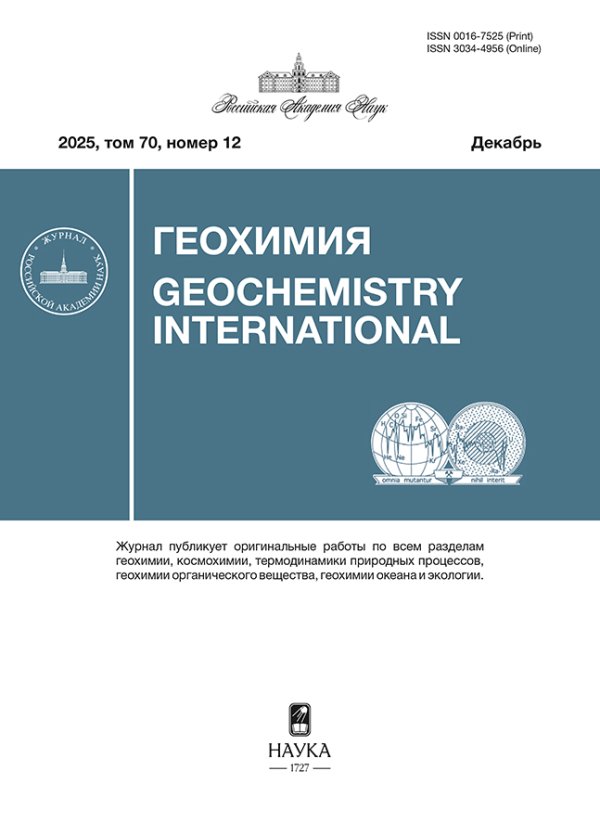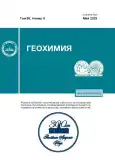Geochemistry of Trace Elements in Minerals of Porphyritic and Nonporphyritic Chondrules from Equilibrated Ordinary Chondrites
- Authors: Sukhanova K.G.1, Skublov S.G.1,2, Galankina O.L.1, Obolonskaya E.V.2, Kotova E.L.2
-
Affiliations:
- Institute of Precambrian Geology and Geochronology, Russian Academy of Sciences
- Saint-Petersburg Mining University
- Issue: Vol 68, No 5 (2023)
- Pages: 454-470
- Section: Articles
- URL: https://journals.rcsi.science/0016-7525/article/view/134807
- DOI: https://doi.org/10.31857/S0016752523050072
- EDN: https://elibrary.ru/ELTYWE
- ID: 134807
Cite item
Full Text
Abstract
The paper presents the results of SIMS and EPMA studies of silicate minerals and bulk compositions (SEM-EDS) of porphyritic and nonporphyritic chondrules from equilibrated ordinary chondrites. The trace-element distribution in olivine, low-Ca pyroxene, and mesostasis of porphyritic and nonporphyritic chondrules in the equilibrated ordinary chondrites reflects heterogeneous conditions of chondrule-forming processes in the protoplanetary disk and provides insight in their evolution. The porphyritic chondrules are composed of olivine with the low content of Y and Yb relative to nonporphyritic chondrules. The enrichment of low-Ca pyroxene from porphyritic chondrules in trace elements correlates with the amount of pyroxene in the chondrule. Olivine composition in granular chondrules is close to that of porphyritic chondrules, but low-Ca pyroxene is distinguished by the high content of Y, Ti, Sr, Ba, V, and REE compared to all other chondrules. Barred chondrules are characterized by olivine enriched in trace elements (Zr, Y, Ti, Ba, Cr, and HREE) and low-Ca pyroxene highly depleted in trace elements (Zr, Y, Nb). The pyroxene of radial chondrules is enriched in Nb, Sr, and Ba. Trace elements in olivine and low-Ca pyroxene indicate the formation of the porphyritic and granular chondrules in a stable region of the protoplanetary disk, which is responsible for low-temperature heating and slow cooling of a chondrule. Trace element enrichment of olivine from the barred chondrules testifies strong heating of a precursor material and rapid cooling of the chondrule melt. Mineral composition of radial chondrules demonstrate rapid cooling of a low-temperature melt depleted in Mg and trace elements. High melt temperatures of barred chondrules and rapid cooling of nonporphyritic chondrules indicate their formation in an unstable region of the protoplanetary disk. Trace elements in silicate minerals of porphyritic and nonporphyritic chondrules reflect their formation as a result of melting of precursor minerals.
About the authors
K. G. Sukhanova
Institute of Precambrian Geology and Geochronology, Russian Academy of Sciences
Email: cris.suhanova92@yandex.ru
199034, St. Petersburg, Russia
S. G. Skublov
Institute of Precambrian Geology and Geochronology, Russian Academy of Sciences; Saint-Petersburg Mining University
Email: skublov@yandex.ru
199034, St. Petersburg, Russia; 199106, St. Petersburg
O. L. Galankina
Institute of Precambrian Geology and Geochronology, Russian Academy of Sciences
Email: skublov@yandex.ru
199034, St. Petersburg, Russia
E. V. Obolonskaya
Saint-Petersburg Mining University
Email: skublov@yandex.ru
199106, St. Petersburg
E. L. Kotova
Saint-Petersburg Mining University
Author for correspondence.
Email: skublov@yandex.ru
199106, St. Petersburg
References
- Суханова К.Г., Скублов С.Г., Галанкина О.Л., Оболонская Э.В., Котова Е.Л. (2019). Редкие элементы в пироксене радиальных хондр обыкновенных равновесных хондритов. Физико-химические и петрофизические исследования в науках о Земле, 320-323.
- Суханова К.Г., Скублов С.Г., Галанкина О.Л., Оболонская Э.В., Котова Е.Л. (2020) Редкоэлементный состав силикатных минералов в хондрах и матрице метеорита Бушхов. Геохимия. 65(12), 1176-1185.
- Sukhanova K.G., Skublov S.G., Galankina O.L., Obolonskaya E.V.,Kotova E.L. (2020) Trace Element Composition of Silicate Minerals in the Chondrules and Matrix of the Buschhof Meteorite. Geochemistry International. 58(12), 1321-1330.
- Суханова К.Г. (2022) Состав силикатных минералов как отражение эволюции равновесных обыкновенных хондритов. Дис. … канд. геол.-мин. наук. Санкт-Петербург: Институт геологии и геохронологии докембрия РАН, 210 с.
- Amelin Y., Krot A. (2007) Pb isotopic age of the Allende chondrules. MAPS. 42(7–8), 1321-1335.
- Connelly J.N., Bizzarro M., Krot A.N., Nordlund Å., Wielandt D., Ivanova M.A. (2012) The absolute chronology and thermal processing of solids in the solar protoplanetary disk. The absolute chronology and thermal processing of solids in the solar protoplanetary disk. 338(6107), 651-655.
- Hewins R., Connolly H., Lofgren Jr G., Libourel G. (2005) Experimental constraints on chondrule formation. Chondrites and the protoplanetary disk, 286.
- Chondrules: Records of Protoplanetary Disk Processes (Eds. S.S. Russell, H.C. Connolly Jr, A.N. Krot). (2018) Cambridge University Press. 450 p.
- Batanova V., Suhr G., Sobolev A. (1998) Origin of geochemical heterogeneity in the mantle peridotites from the Bay of Islands ophiolite, Newfoundland, Canada: ion probe study of clinopyroxenes. GCA. 62(5), 853-866.
- Bischoff A., Schleiting M., Wieler R., Patzek M. (2018) Brecciation among 2280 ordinary chondrites – Constraints on the evolution of their parent bodies. GCA. 238, 516-541.
- Dodd R.T., Hutchison R. (2004). Meteorites: A petrologic, chemical and isotopic synthesis: Cambridge University Press, 506 p.
- Engler A., Varela M.E., Kurat G., Ebel D., Sylvester P. (2007) The origin of non-porphyritic pyroxene chondrules in UOCs: Liquid solar nebula condensates? The origin of non-porphyritic pyroxene chondrules in UOCs: Liquid solar nebula condensates? 192(1), 248-286.
- Gooding J.L., Keil K., Fukuoka T., Schmitt R.A. (1980) Elemental abundances in chondrules from unequilibrated chondrites: evidence for chondrule origin by melting of pre-existing materials. EPSL. 50(1), 171-180.
- Hsu W., Crozaz G. (1998) Mineral chemistry and the origin of enstatite in unequilibrated enstatite chondrites. GCA. 62(11), 1993-2004.
- Jacquet E., Alard O., Gounelle M. (2015) Trace element geochemistry of ordinary chondrite chondrules: The type I/type II chondrule dichotomy. GCA. 155, 47-67.
- Jones R.H., Grossman J.N., Rubin A.E. (2005) Chemical, mineralogical and isotopic properties of chondrules: Clues to their origin. Chondrites and the protoplanetary disk, 251.
- Kennedy A.K., Lofgren G.E., Wasserburg G.J. (1993) An experimental study of trace element partitioning between olivine, orthopyroxene and melt in chondrules: equilibrium values and kinetic effects. EPSL. 115(1–4), 177-195.
- Krot A.N., Meibom A., Weisberg M.K., Keil K. (2002) The CR chondrite clan: Implications for early solar system processes. MAPS. 37(11), 1451-1490.
- Krot A.N., Nagashima K., Libourel G., Miller K.E. (2018) Multiple Mechanisms of Transient Heating Events in the Protoplanetary Disk: Evidence from Precursors of Chondrules and Igneous Ca, Al-Rich Inclusions. In: Chondrules: Records of Protoplanetary Disk Processes. Ed. S.S. Russell, H.C. Connolly Jr, A.N. Krot. Cambridge University Press, 2018. 22, 450.
- Libourel G., Krot A.N. (2007) Evidence for the presence of planetesimal material among the precursors of magnesian chondrules of nebular origin. EPSL. 254(1–2), 1-8.
- Nehru C.E., Weisberg M.K., Prinz M. (1994) Porphyritic versus nonporphyritic chondrules. Chondrules and the Protoplanetary Disk, 26-27.
- Nosova A., Narkisova V., Sazonova L., Simakin S. (2002) Minor elements in clinopyroxene from Paleozoic volcanics of the Tagil island arc in the Central Urals. Geochem. Int. 40(3), 219-232.
- Oulton J., Humayun M., Fedkin A., Grossman L. (2016) Chemical evidence for differentiation, evaporation and recondensation from silicate clasts in Gujba. GCA. 177, 254-274.
- Palme H., Lodders K., Jones A. (2014) Solar system abundances of the elements. In: Planets, Asteriods, Comets and The Solar System. Vol. 2 of Treatise on Geochemistry (Second Ed.). Ed. A.M. Davis. Elsevier, 2014. 2, 15-36.
- Portnyagin M., Almeev R., Matveev S., Holtz F. (2008) Experimental evidence for rapid water exchange between melt inclusions in olivine and host magma. EPSL. 272(3–4), 541-552.
- Radomsky P.M., Hewins R.H. (1990) Formation conditions of pyroxene-olivine and magnesian olivine chondrules. GCA. 54(12), 3475-3490.
- Ray D., Ghosh S., Goswami T.K., Jobin M.J. (2017) Insights into chondrule formation process and shock-thermal history of the Dergaon chondrite (H4-5). GSF. 8(3), 413-423.
- Saito T., Shimizu H., Masuda A. (1998) Experimental study of major and trace element partitioning among olivine, metallic phase and silicate melt using chondrite as starting material: Implication for V-shaped REE patterns of the pallasite meteorites. GCA. 32(3), 159-182.
- Tenner T.J., Nakashima D., Ushikubo T., Kita N.T., Weisberg M.K. (2015) Oxygen isotope ratios of FeO-poor chondrules in CR3 chondrites: Influence of dust enrichment and H2O during chondrule formation. GCA. 148, 228-250.
- Varela M.E. (2019) Bulk trace elements of Mg-rich cryptocrystalline and ferrous radiating pyroxene chondrules from Acfer 182: Their evolution paths. GCA. 257, 1-15.
- Varela M.E., Sylvester P., Brandstätter F., Engler A. (2015) Nonporphyritic chondrules and chondrule fragments in enstatite chondrites: Insights into their origin and secondary processing. MAPS. 50(8), 1338-1361.
- Varela M.E., Sylvester P., Engler A., Kurat G. (2012) Nonporphyritic chondrules from equilibrated Rumuruti and ordinary chondrites: Chemical evidence of secondary processing. MAPS. 47(10), 1537-1557.
Supplementary files

















